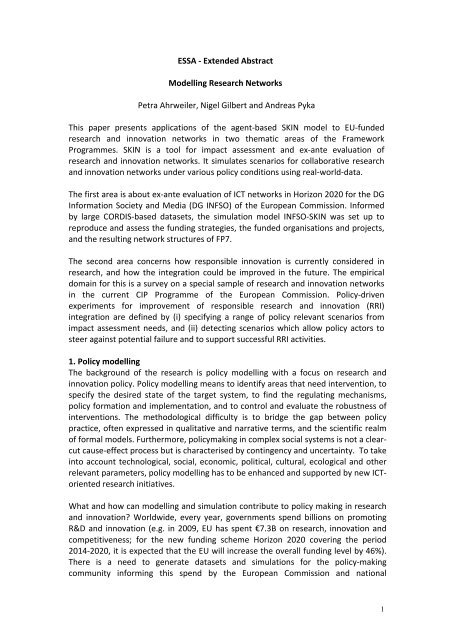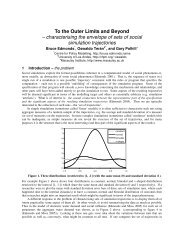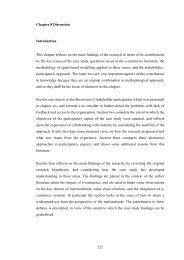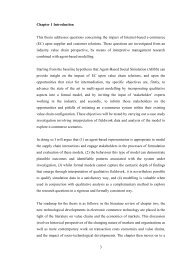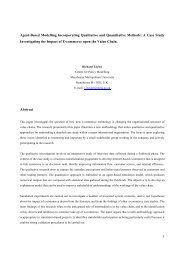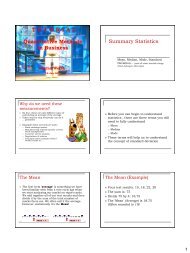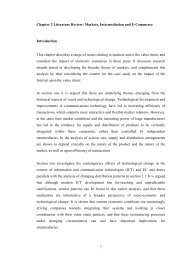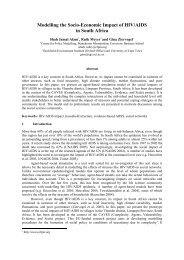Extended Abstract - Centre for Policy Modelling
Extended Abstract - Centre for Policy Modelling
Extended Abstract - Centre for Policy Modelling
Create successful ePaper yourself
Turn your PDF publications into a flip-book with our unique Google optimized e-Paper software.
ESSA -‐ <strong>Extended</strong> <strong>Abstract</strong> <strong>Modelling</strong> Research Networks Petra Ahrweiler, Nigel Gilbert and Andreas Pyka This paper presents applications of the agent-‐based SKIN model to EU-‐funded research and innovation networks in two thematic areas of the Framework Programmes. SKIN is a tool <strong>for</strong> impact assessment and ex-‐ante evaluation of research and innovation networks. It simulates scenarios <strong>for</strong> collaborative research and innovation networks under various policy conditions using real-‐world-‐data. The first area is about ex-‐ante evaluation of ICT networks in Horizon 2020 <strong>for</strong> the DG In<strong>for</strong>mation Society and Media (DG INFSO) of the European Commission. In<strong>for</strong>med by large CORDIS-‐based datasets, the simulation model INFSO-‐SKIN was set up to reproduce and assess the funding strategies, the funded organisations and projects, and the resulting network structures of FP7. The second area concerns how responsible innovation is currently considered in research, and how the integration could be improved in the future. The empirical domain <strong>for</strong> this is a survey on a special sample of research and innovation networks in the current CIP Programme of the European Commission. <strong>Policy</strong>-‐driven experiments <strong>for</strong> improvement of responsible research and innovation (RRI) integration are defined by (i) specifying a range of policy relevant scenarios from impact assessment needs, and (ii) detecting scenarios which allow policy actors to steer against potential failure and to support successful RRI activities. 1. <strong>Policy</strong> modelling The background of the research is policy modelling with a focus on research and innovation policy. <strong>Policy</strong> modelling means to identify areas that need intervention, to specify the desired state of the target system, to find the regulating mechanisms, policy <strong>for</strong>mation and implementation, and to control and evaluate the robustness of interventions. The methodological difficulty is to bridge the gap between policy practice, often expressed in qualitative and narrative terms, and the scientific realm of <strong>for</strong>mal models. Furthermore, policymaking in complex social systems is not a clear-cut cause-‐effect process but is characterised by contingency and uncertainty. To take into account technological, social, economic, political, cultural, ecological and other relevant parameters, policy modelling has to be enhanced and supported by new ICT-oriented research initiatives. What and how can modelling and simulation contribute to policy making in research and innovation? Worldwide, every year, governments spend billions on promoting R&D and innovation (e.g. in 2009, EU has spent €7.3B on research, innovation and competitiveness; <strong>for</strong> the new funding scheme Horizon 2020 covering the period 2014-‐2020, it is expected that the EU will increase the overall funding level by 46%). There is a need to generate datasets and simulations <strong>for</strong> the policy-‐making community in<strong>for</strong>ming this spend by the European Commission and national 1
Governments. Recent developments move in the direction of advanced ICT tools <strong>for</strong> research and innovation policy modelling, prediction of policy impacts, development of new governance models and collaborative solving of complex policy problems. These tools enable the modelling of R&D policy initiatives taking into account relevant parameters and per<strong>for</strong>ming social simulations to <strong>for</strong>ecast potential impacts of proposed R&D policy measures. The approach and the related research is novel in two respects: • It focuses on knowledge exchange and mutual knowledge creation in innovation and research networks. Since collaborative innovation has become the dominant and most promising way to produce high-‐quality output, these collaboration structures have become an important target <strong>for</strong> policy interventions as well as <strong>for</strong> the evaluation of policy impacts. Without the consideration of interactions among heterogeneous actors in networks, knowledge generation and diffusion processes cannot be understood and effective policy instruments cannot be designed; • It allows <strong>for</strong> considering innovations as real novelties. The traditional methodological framework referring to optimal decisionmaking is no longer applicable. <strong>Policy</strong> design and evaluation methods in this area are challenged by the imponderability of research and innovation, which are characterised by true uncertainty and are exposed to failures. There<strong>for</strong>e, optimization approaches are not suited; instead innovation research has to acknowledge the possibility of novel behaviours (including failure) as a likely outcome, which, however, might be considered as an important source of knowledge to guide further research. In this paper we introduce agent-‐based modelling as an alternative approach, which allows <strong>for</strong> the explicit consideration of true uncertainty in innovation as well as the interaction of heterogeneous agents in research and innovation networks. Recent studies of network architectures and their dynamics (see next section) indicate that the success of innovation networks is related to specific network structures as well as mechanisms of network evolution. The emergence of these network structures and their underlying dynamics are not accessible with numerical simulations. There is scope <strong>for</strong> the improvement of the policy instruments used to create and to support innovation networks by applying the computational approach of agent based modelling. The first conceptual frameworks <strong>for</strong> understanding policy interventions in social systems were linear. This has been true <strong>for</strong> all policy areas, whether they be regulatory, distributive, or coordinative. However, it began to be realised that the linear top-‐down idea of triggering a desired system per<strong>for</strong>mance on the macro level was clearly amiss. The resulting critique of the linear model led to concepts such as the garbage-‐can-‐model of policymaking. <strong>Policy</strong>making in complex social systems is characterised by contingency and uncertainty. These terms were e.g. used to criticise the principal-‐agent theory of policymaking following the observation that the principal is not able to control the agent but has a serious contractual problem. <strong>Policy</strong>makers face policy problems in contexts: an agent who is subject to certain strategic behaviours of other agents is located in a technological, regulatory, political, 2
economic context, has a certain experience and history of others’ strategic behaviours, is situated in a certain competition/cooperation structure with other agents, is changing over time and so on. Furthermore, strategy <strong>for</strong>mation is no longer a privilege of governmental actors. In most policy domains, the term “governance” hints at the fact that there are non-‐governmental actors involved in policymaking and control issues. The term “organisational governance” refers to the fact that coordination mechanisms appear from the interaction of participating agents in a sector. These strategies and coordination mechanisms might further interfere with desired goals and impacts of governmental policy strategies. The policy process can give rise to all sorts of positive feedback mechanisms: changes in policy lead to changes in actor behaviour, which can again invoke new policy problems. Alternative models, such as the neo-‐liberal model of policy making, there<strong>for</strong>e erased the notions of sequentiality and linearity, and centred instead on processes of recursive learning, self-‐organisation, and non-‐linear dynamics. The problems with techniques that rely on the linearity of societal processes and predictability of future states inferred from past data and estimated from simple explanatory models such as <strong>for</strong>ecasting have been discussed along the same lines. For an evidence-‐based and computational approach to policy design we need the ability to identify potential futures. Since it is impossible to predict future system states due to the underlying complex micro dynamics of social systems, even <strong>for</strong> <strong>for</strong>esight exercises, it would not be reasonable to insist on examining the most likely future scenario but to compare and analyse interventions, their side effects, their bottlenecks and constraints in a set of possible future developments. Reviewing the current state-‐of-‐the-‐art of policy context analysis such as <strong>for</strong>ecasting, <strong>for</strong>esight, backcasting, impact assessment, scenarios, early warning systems, and technology roadmapping, the need <strong>for</strong> policy intelligence dealing with complexity becomes more and more obvious. A particular challenge is the relationship between large-‐scale quantitative data and <strong>for</strong>mal policy models. This is a twofold issue: First, providing knowledge discovery and data mining techniques <strong>for</strong> large and heterogeneous databases is an urgent requirement <strong>for</strong> policy analysis in general. Second, to connect these large databases to <strong>for</strong>mal models constitutes a methodological gap in the existing state-‐of-‐the-‐art. 2. The SKIN model <strong>for</strong> complex research and innovation policy simulation By providing a conceptual framework <strong>for</strong> the combined application of empirical research, computational network analysis, and agent-‐based modelling, this paper presents a novel and working methodology that allows <strong>for</strong> a fully integrated and more comprehensive understanding of research policymaking than has hitherto been achieved. The potential <strong>for</strong> roll-‐out of the methodology suggests that the approach could ultimately create methodological foundations <strong>for</strong> the sustainable trans<strong>for</strong>mation of research and innovation landscapes. The intended output of our study is to provide indications and directions <strong>for</strong> increasing the ability to sustain effective R&D policymaking using ICT. Just as the results can better in<strong>for</strong>m policymaking, they can also in<strong>for</strong>m strategic decision-‐making <strong>for</strong> private enterprise. 3
To meet these research objectives, agent-‐based modelling (ABM) is used – a powerful and innovative methodology, which is gaining more and more prominence in the scientific community – to identify and understand the effects of certain research policy strategies and their associated knowledge dynamics. In contrast to conventional methods of social research, this method is capable of dealing with the high complexity and non-‐linearity of the processes under study. ABM users can address questions that involve different levels of the innovation ecosystem: from start-‐up firms (micro level) to academic-‐industry partnerships (meso level) to whole sectors or regions (macro level). ABMs can be in<strong>for</strong>med by large empirical data sets. Our model (Simulating Knowledge Dynamics in Innovation Networks, SKIN) exactly contains these components: SKIN is a multi-‐agent model containing heterogeneous agents that act and interact in a complex and changing environment. The agents represent innovative actors who try to sell their innovations to other agents and end users but who also have to buy raw materials or more sophisticated inputs from other agents (or material suppliers) in order to produce their outputs. This basic model of a market is extended with a representation of the knowledge dynamics in and between the agents. Each agent tries to improve its innovation per<strong>for</strong>mance and its sales by improving its knowledge base through adaptation to user needs, incremental or radical learning, and co-‐operation and networking with other agents. SKIN is grounded in empirical research and theoretical frameworks from innovation economics and economic sociology. It is the result of a number of projects that combined empirical research into innovation networks with agent-‐based simulation. The model was used by the European Commission <strong>for</strong> scenario modelling of current and future innovation policy strategies referring to the technological sectors and EU Member States of the case studies. 3. The INFSO-‐SKIN application: ex-‐ante evaluation of Horizon 2020 To illustrate how the SKIN model works <strong>for</strong> research policy, the first application concerns the ex-‐ante impact assessment of ICT research in Horizon 2020, which was the subject of a tender study <strong>for</strong> the Evaluation Unit of DG INFSO (http://ec.europa.eu/dgs/in<strong>for</strong>mation_society/evaluation/index_en.htm). To address the evaluative questions of DG INFSO as stakeholder of the study, the FP7 model extrapolated into the future without any policy changes is taken as an evidence-based benchmark <strong>for</strong> further experiments. Against this baseline scenario the following example policy changes are tested to show the applicability of the model: (i) What if there would be changes to the instruments of funding? (ii) What if there would be changes to the overall amount of programme funding? The results of these simulation experiments reveal some likely scenarios as policy options <strong>for</strong> Horizon 2020. The study’s methodology of modelling the long-‐term impact of FP policies and assessing expectations <strong>for</strong> ICT research in Horizon 2020 had to be suitable <strong>for</strong> the following tasks: • Use the DG INFSO database on FP7 ICT networks as data input to calibrate the 4
simulation model (starting networks) • Process this data in simulation experiments with different policy scenarios starting from FP7 <strong>for</strong> Horizon 2020 impact assessment / ex-‐ante evaluation (monitoring networking effects over time and policy impact simulation) • Analyse and interpret the simulated network data <strong>for</strong> Horizon 2020 impact assessment / ex-‐ante evaluation Figure 1: Workflow of the study’s methodological framework (numbers indicate the single steps; circles indicate the software interfaces between the single steps) The policy changes <strong>for</strong> ex-‐ante evaluation of the new programme resulted in networks and knowledge flows, which were then compared with the baseline simulation of the unmodified FP7 ICT Calls 1-‐6. Differences between the behaviour in the experiments and that in the baseline can be attributed to the effects of the policy change. In detail, the Experiments to address DG INFSO’s evaluative questions as mentioned above were: Altering the scope of the calls Increasing or decreasing the number of calls by one. Current EU funding programmes put considerable emphasis on tackling societal challenges through the encouragement of specific technology themes, bringing researchers from across Europe together in collaborative networks. What have become clear, however, are “the limitations of this approach in achieving the necessary flexibility, creativity and cross-‐disciplinary research needed.” Changes in the policy levers applied to influence the development of innovation networks are clearly required, but deciding which changes, and predicting their outcomes, is difficult. How the network will actually react to changes in this “thematic technology push” approach is crucial <strong>for</strong> an ex-‐ante evaluation of networks built through collaborative research at European level designed to develop and support the underlying knowledge landscape in European networks. Do policy makers reduce thematic areas in an attempt to prioritise the remaining research challenges? Or do they extend the existing thematic reach even further? 5
Our first pair of experiments was designed to establish the impact of changing the number technology themes supported by FP funding. Specifically, we looked at what happened if the number of thematic areas was increased or reduced by one. Intuitively, changing the number of knowledge fields should alter the overall transfer of knowledge with the network, because the likelihood of agents with similar knowledge meeting within the network will vary with the number of knowledge fields included. However, surprisingly the simulations showed that varying the scope of the calls had no effect on the number of participants, proposals or eventual projects. The implication <strong>for</strong> policy is that new thematic areas could be integrated (or existing areas deleted) without any significant effect on existing networks. So the decision to add (or remove) thematic areas could be taken from a purely political stance, without worrying about the effect on underlying network structures. Changing funding levels per project Varying the amount of funding per project or by project member An obvious policy instrument is to change the amount of funding – either per Call or per project. We were interested in: • what happens if the funding received by individual consortium members changes; • what happens if the amount of project funding available in total changes. This experiment echoes question 5 of the public consultation Green Paper on Horizon 2020: “What should be the balance between smaller, targeted projects and larger, strategic ones?” One of the suggestions is that funding opportunities should have sufficient scope <strong>for</strong> smaller projects and consortia because these encourage more innovation. Interestingly, our experimental results showed that smaller consortia sizes and lower monthly funding rates had a beneficial effect on the <strong>for</strong>mation of research networks – which was one of the recommendations of the respondents to the Green Paper. While larger projects with extremely high funding may be required <strong>for</strong> other reasons, they do not seem to be supportive of the network related goals. Changing funding levels per programme Varying funding levels <strong>for</strong> the overall programme, leaving funding per participant unchanged Rather than changing the funds available per participant the funds per Call can be varied, leaving the average funding per project participant unchanged. In this experiment we test what happens if we make changes in the funding level <strong>for</strong> the overall programme. Unsurprisingly, we found that decreasing funding leads to more competition <strong>for</strong> the available projects. In the model, more proposals are submitted because many uninvolved agents try to connect to the network; however, because of the decrease in funding a smaller number of projects are financed, and overall knowledge flows decrease through the network. Conversely, an increase in funding leads to more projects being funded, more knowledge flows between actors stronger connections between consortia. Evidently the number of projects funded and the degree of overall knowledge flow through collaborative networks is proportional to the amount of money made available overall. 6
The effect of SMEs The role of SMEs in networks Because they are usually more flexible and agile than larger organisations, SMEs play a crucial role in the development of new products and services. The most dynamic and innovative SMEs have the potential to trans<strong>for</strong>m the structure of Europe's economy by growing into tomorrow's multinationals. However, although the CIP has been successful in reaching SMEs and although particular attention has been paid to increasing SME involvement throughout FP7, they are still finding it difficult to get involved. Thought has been given to how to make it more likely that SMEs will successfully join research networks – we were interested in how these networks will be affected as a result of changed SME participation. So, in the final pair of experiments we first considered the effect of having a larger number of SMEs participating in the programme. Then we changed the orientation of the evaluation criteria used to judge proposals to favour more applied work (which should favour SMEs). As we expected, we see more SMEs in the final network if there are more SMEs at the starting phase. We also find more proposals where consortia can more easily meet the eligibility criteria, which often require SME participation. Overall there are not significantly more or less projects than in the Baseline Scenario, but there are significant differences in the consortium structures: with fewer research institutions and fewer large diversified firms but a greater amount of SMEs. The conclusion has to be that encouraging more SMEs to pitch <strong>for</strong> projects under FP Calls would be in itself a sufficient trigger to increase FP participation by SMEs because they tend to be successful in the competitive process of proposal evaluation. 4. The INFSO-‐SKIN application <strong>for</strong> responsible research and innovation (RRI) CIP projects provide a field of mixed research and innovation networks involving stakeholders and technology users, which make them unique <strong>for</strong> investigating responsible practices in research AND innovation, and analyse the interaction between these two. The special programme within CIP (ICT-‐based public sector trans<strong>for</strong>mation) is about emerging technology but also about social innovation, is especially stakeholder-driven but not too sensitive and not too big. The intertwined topics represented in a pool from CIP research (democratised research and responsible innovation, participation and responsibility, emerging technologies and social challenges etc.) are especially well represented in this area. Calibrated by data from this survey, we apply and further develop the SKIN-‐INFSO model. Simulations experiment with policies <strong>for</strong> implementing responsible innovation strategies in research and evaluate future scenarios. For this, policy-driven experiments <strong>for</strong> improvement of responsible research and innovation (RRI) integration are defined (i) specifying a range of policy relevant scenarios from impact assessment needs, and (ii) detecting scenarios which allow policy actors to steer against potential failure and to support successful RRI activities. 7


